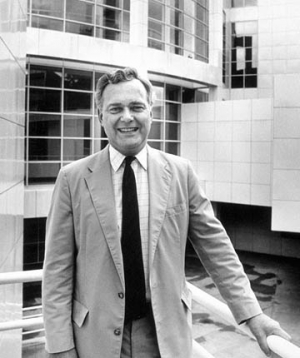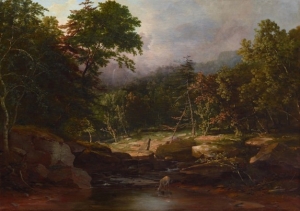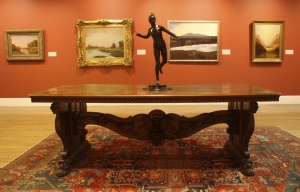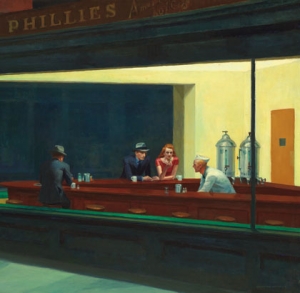|
Displaying items by tag: american

Thomas Hart Benton’s (1889-1975) epic mural, America Today (1930-31) has found a new home at New York’s Metropolitan Museum of Art. A sweeping panorama of American life, the work once lined a boardroom at the International-Style New School for Social Research on West 12th Street, which was designed by the Austrian architect, Joseph Urban (1872-1933).
The 10-panel mural, which was Benton’s first major commission, ushered in a new approach to mural painting, turning to the reality of everyday life for inspiration. America Today portrays American life prior to the Great Depression and features the flappers, farmers, steel workers, and stock market moguls that are readily associated with the period. The mural remains Benton’s best-known work and a masterpiece of modern art.
Benton, an American realist painter, drew inspiration for the mural from his travels around the United States in the 1920s. A glimpse into both rural and urban life at the time, America Today portrays the wealthy and poor as well as the progressive and traditional ideals that defined the era. While Benton did not receive a fee for the commission, the work opened the door for future commissions and helped inspire the Works Progress Administration mural programs that were implemented in the late 1930s.
Bought by the insurance company, AXA Equitable, nearly 30 years ago, America Today was in storage before the decision to donate the work was made. However, the Met is currently without extra exhibition space and the mural won’t be on view until at least 2015 when the museum takes over the Whitney Museum of American Art’s Marcel Breuer building on Madison Avenue. The Whitney is headed to its own larger space in the meatpacking district. America Today is the first artwork that Met officials have confirmed for the Breuer building.
Founded in 1998 by husband and wife team Judy Goffman Cutler and Laurence S. Cutler, the National Museum of American Illustration art (NMAI) is the first institution in the country to be devoted entirely to American illustration (Fig. 1). A private, nonprofit organization, the NMAI was originally built to house the Cutlers' personal art collection, an assemblage of works from the Golden Age of American illustration, a period lasting from 1895 until 1945. The Golden Age was a direct result of the vast improvements in printing technology at a time when newspapers, magazines, and illustrated books were the main source of media. No longer constrained by the limits of the medium, illustrators were able to freely experiment with color and new techniques. With assistance from the National Arts Club, a private club devoted to promoting public interest in the arts, the NMAI opened its doors to the public in 2000.

When Gudmund Vigtel was named the High Museum of Art’s director in 1963, it was a sensitive time for Atlanta’s art world. More than 100 members of the Atlanta Arts Association and their family members had died the year before in a tragic plane crash. The city’s civic leaders hoped that Vigtel could turn the museum into a living monument of sorts.
Vigtel came to the High Museum from the Corcoran Gallery of Art in Washington where he served as the assistant director. Civic leaders turned to Vigtel to spearhead the fund-raising campaign they started with hopes of remaking the museum. As it turns out, they chose the right man for the job.
During his 28 years at the High Museum, Vigtel transformed it from an unsuspecting, modest institution to one of the U.S.’s most renowned art museums. Vigtel oversaw the museum’s move from a small brick building to an architecturally groundbreaking 135,000-square-foot postmodern structure designed by Richard Meier. While the relocation happened in 1983, Vigtel began fund-raising and seeking out an architect in the mid-1970s.
Vigtel tripled the size of the High’s permanent collection and implemented an art appreciation program for children. He also started one of the country’s first African-American art collections. The decorative arts collection he opened at the museum has gone on to become one of the finest in the country. After acquiring hundreds of works by 19th- and 20th-century American and European artists, Vigtel left the High Museum with a $15 million endowment, which has since grown.
Vigtel died at his home in Atlanta at the age of 87. His wife, two daughters, four grandchildren, and a profound legacy survive him.

A curator at the Dallas Museum of Art discovered an unsigned painting likely created by the American landscape painter, George Inness. The work has been in the museum’s collection for more than 80 years but had been attributed to Asher B. Durand, one of the leading figures of the Hudson River School painters. The mid-19th century art movement had a profound influence on Inness’ work.
After experts at the museum questioned In the Woods’ attribution, American art curator Sue Canterbury decided to do some research on the oil on canvas. Canterbury explored other artists whose work fit with In the Woods’ aesthetic and stumbled upon Michael Quick’s George Inness: A Catalogue Raisonne. Within the raisonne Canterbury found a pen and ink drawing that bore a striking resemblance to In the Woods. It was then that the museum decided to reattribute the painting to Inness.
The bucolic forest scene has been renamed Stream in the Mountains by curators and will be display at the museum. It is a significant work because it is from Inness’ early years and not many of his works from this era have survived.

After twenty-two years, Nicholas Capasso will be leaving his post at the deCordova Sculpture Park and Museum in Lincoln, MA. Capasso, who is currently the deCordova’s deputy director for Curatorial Affairs, has been named the new director of the Fitchburg Art Museum and will start his latest venture on December 3.
During his time at the deCordova, Capasso has overseen a permanent collection that included 3,500 objects, changing gallery exhibitions, and an outdoor sculpture park. He helped to bring recognition to the institution and to reposition it as an important contemporary museum.
While Capasso specializes in contemporary art, he is eager to work with the Fitchburg Art Museum’s collection that spans more than 5,000 years and includes American and European paintings, prints, drawings, ceramics, decorative arts, and Greek, Roman, Asian, and pre-Columbian antiquities. The Museum’s collection, which is housed between twelve galleries, includes works by William Zorach, John Singleton Copley, Joseph Stella, Edward Hopper, Charles Burchfield, Charles Sheeler, Walker Evans, and Georgia O’Keeffe.
Capasso will take over the role of director from the soon-to-be-retired Peter Timms who has held the position since 1973.
Art collector, philanthropist, and financier, Eli Broad, announced this week that he will donate 19 works to the Eli and Edythe Broad Art Museum at his alma mater, Michigan State University. The contemporary art museum is slated to open on November 10th. Designed by the architect, Zaha Hadid, the 46,000-square-foot museum was expected to open in April but was delayed due to construction.
Broad’s donation includes a large-scale piece, Containment 1, by the American sculptor Roxy Paine that will be displayed outdoors. There are other works by various artists including Robert Longo, Elizabeth Murray, Terry Winters, and Jonathan Lasker, which are worth around $2 million collectively.
Broad donated $28 million for the museum, with $21 million going toward construction and $7 million for acquisitions, exhibitions, and other functions. Michael Rush, the museum’s director, is curating the inaugural show.

There was a time when Anthony Van Dyck’s Isabella, Lady de La Warr was considered one of the most important paintings at Boston’s Museum of Fine Arts. Purchased in 1930 for $121,440 by the MFA donor, Mrs. Frederick T. Bradbury, the work went on view in the Hamilton Palace period room. It wasn’t until the 1980s when the painting went into storage that Isabella’s future started to look bleak.
When Malcolm Rogers rediscovered Isabella not long after he took over as the MFA’s director in 1994, he found the painting’s surface was discolored from protective varnishes and shoddy retouching had left the work with mismatched paint. Painted by the Flemish artist in 1638 during a stay in England, Rogers knew that Isabella could be recovered. A technical examination in 2011 reinforced Rogers’ belief.
The painting underwent nearly a year of restoration by the MFA’s paintings conservator, Rhona MacBeth and has just been installed in the MFA’s newly renovated Koch Gallery. Depicting an elegant woman, the wife of Lord Henry who served as a diplomat and treasurer of one of Van Dyck’s most famous subjects, England’s King Charles I, the painting is an excellent example of aristocratic portraiture that was in high demand by American collectors during the first few decades of the 20th century.

The Huntington Library, Art Collections, and Botanical Gardens acquired thirteen pieces of furniture by the American architect, Frank Lloyd Wright. The selection of furniture had previously been on display at the Library since 2009 as part of a long-term loan from the prominent New York collectors, Joyce and Erving Wolf. The purchase was made directly from the Wolfs for an undisclosed amount.
The highlight of the group is a nine-piece dining room suite designed in 1899 for the now-demolished Husser House in Chicago. The commission marked a turning point in Wright’s career as he moved away from his more architecturally rigid views on interiors towards the notion that interior space can be open and flowing. The other four pieces in the acquisition were from signature Wright houses in Illinois including the Avery Coonley House, the Arthur Heurtley House, the Little House (which has been demolished), and the Ward W. Willits House.
One of the greatest architects of the 20th century, Wright played a pivotal part in changing design sensibilities from the highly ornate styles of the late-19th century to more streamlined designs for modern times. In addition to developing plans for upward of a thousand buildings, Wright designed furniture, leaded-glass windows, light fixtures, metal ware, and textiles – all made to harmonize with the buildings for which they were intended.

Best known for his paintings of stark diner scenes, snapshots of city life, and quiet portraits of the American landscape, there is much more to Edward Hopper’s (1882–1967) oeuvre than one might think. Referred to as a romantic, a realist, a symbolist, and even a formalist, the exhibition, Paintings by Edward Hopper (1882–1967) currently on view at the Grand Palais, Galeries Nationales in Paris aims to explore each facet of Hopper’s artistic identity.
Divided chronologically into two main parts, the first section of the exhibition covers Hopper’s early work from 1900 to 1924. During this time Hopper studied at the New York School of Art under Robert Henri, the founder of the Ashcan School of realism. Hopper also spent nearly a year in Paris in 1906, followed by shorter stays in 1909 and 1910.
The first part of the exhibition sets out to compare Hopper’s early work to that of his contemporaries as well as to the art he saw while in Paris. While in Europe, Hopper was influenced by such things as Degas’ original angles to Vermeer’s use of light. He was also moved by the soft, harmonious nature of Impressionism, which is reflected in his work from the time. This work is in sharp contrast to the almost gritty realism Hopper favored back in the United States.
1924 marked a turning point in Hopper’s career. After successful exhibitions of his watercolors of neo-Victorian houses in Gloucester, Massachusetts at the Brooklyn Museum and the Franck Rehn’s Gallery (New York), Hopper enjoyed commercial success and was able to fully devote his life to his art. Hopper’s watercolors mark the second section of the Grand Palais exhibition and feature the iconic paintings most people associate with the artist.
Curated by Didier Ottinger, assistant director of the MNAM – Center Pompidou, the exhibition of Hopper’s work will be on view through January 28, 2013.

While sales totaled $3,486,127 million at Sotheby’s American Paintings, Drawings, and Sculpture auction on September 28th in New York, 35% of lots went unsold. Sotheby’s did slightly better than Christie’s in the American Art arena, but both sales are a testament to the lackluster performance of mid-season auctions.
“Sotheby’s did put a few more important paintings in the sale,” said Debra Force of Debra Force Fine Art, Inc. “The question is whether the clientele is there to buy it.” It appears that the clientele interested in purchasing Rockwells were at least in attendance. Is He Coming? (1919), a quintessential Norman Rockwell painting of a young boy and his dog peering up the chimney on what appears to be Christmas Eve, brought in $602,500. The final price was $300,000 more than than the paintings high estimate ($200,000–$300,000).
Sotheby’s sale featured more than 200 paintings, drawings, and sculptures and included property from two noteworthy private collections belonging to Margie and Robert E. Petersen and Susan Kahn Rosenkranz and Richard Rosenkranz. Highlights included works by Rockwell Kent, Marsden Harley, Grandma Moses, and Ben Shahn with Kent and Moses taking two of the top five lots. Moses’ On the Banks of the Hudson reached the third highest price of the sale at $92,500 but still brought in considerably less than its high estimate of $120,000. Rockwell Kent’s Adirondack Farm, Summer sold for $86,5000 (estimate: $25,000–$35,000), the fourth highest sale of the auction.
While the highlights of the auction could have made more money in a more important sale, the quality is there. "Maybe more important collectors need to get used to looking at these mid-season sales," says Force.
|
|
|
|
|